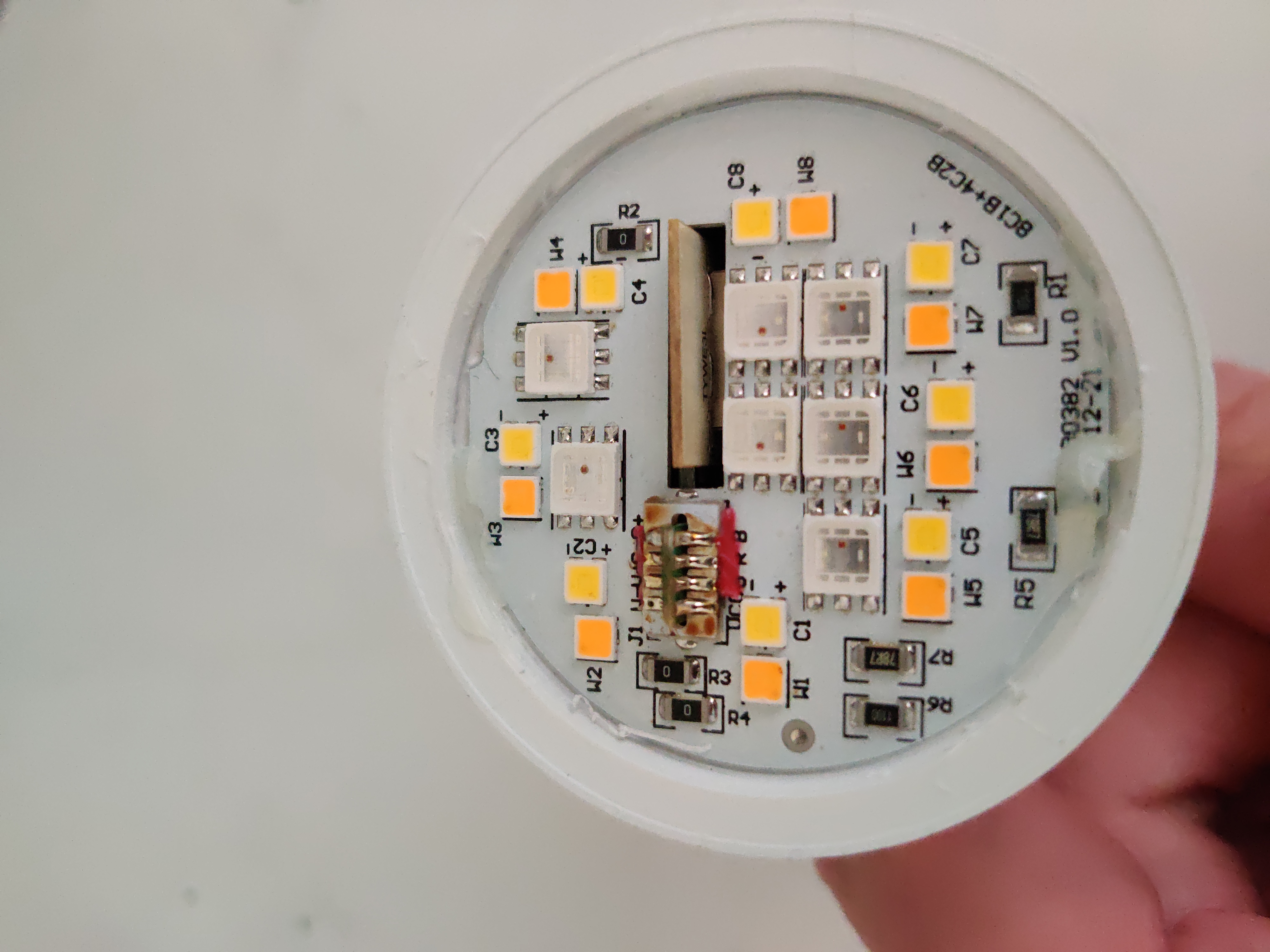Sinvitron A19 900lm RGBCW
Standard RGB warm and cold white bulb. Flashable via tuya-convert. Purchased from Amazon, pack of 2.
Generally don't power on both a white channel and the color channel at full brightness - this can overheat the bulb.
Pictures


GPIO Pinout
| Pin | Function |
|---|---|
| GPIO4 | Red |
| GPIO5 | Cold White |
| GPIO12 | Green |
| GPIO13 | Warm White |
| GPIO14 | Blue |
Basic Configuration
substitutions:
device_name: sinvitron
friendly_name: Sinvitron Bulb
esphome:
name: ${device_name}
esp8266:
board: esp01_1m
wifi:
ssid: !secret wifi_ssid
password: !secret wifi_password
fast_connect: on #we only have one WiFi AP so just use the first one that matches
ap: #since we listed an SSID above, this AP mode will only enable if no WiFi connection could be made
ssid: ${friendly_name}_AP
password: !secret wifi_password
# Enable logging
logger:
baud_rate: 0 #disable UART logging since we aren't connected to GPIO1 TX
# Enable Home Assistant API
api:
# Enable OTA updates
ota:
safe_mode: True
# Enable web server
web_server:
port: 80
output:
- platform: esp8266_pwm
id: red
pin: GPIO4
inverted: False
- platform: esp8266_pwm
id: green
pin: GPIO12
inverted: False
- platform: esp8266_pwm
id: blue
pin: GPIO14
inverted: False
- platform: esp8266_pwm
id: cold_white
pin: GPIO5
inverted: False
- platform: esp8266_pwm
id: warm_white
pin: GPIO13
inverted: False
light:
- platform: rgbww
name: ${friendly_name}
red: red
green: green
blue: blue
cold_white: cold_white
warm_white: warm_white
cold_white_color_temperature: 6500 K
warm_white_color_temperature: 2700 K
id: thelight
restore_mode: ALWAYS_ON #Start with light on after reboot/power-loss event, so that it works from a dumb lightswitch
effects:
- random:
- strobe:
- flicker:
alpha: 50% #The percentage that the last color value should affect the light. More or less the “forget-factor” of an exponential moving average. Defaults to 95%.
intensity: 50% #The intensity of the flickering, basically the maximum amplitude of the random offsets. Defaults to 1.5%.
- lambda:
name: Color Cycle
update_interval: 11s
lambda: |-
static int state = 0;
auto call = id(thelight).turn_on();
call.set_transition_length(10000);
if (state == 0) {
call.set_rgb(1.0, 0.0, 0.0); // red
} else if (state == 1) {
call.set_rgb(1.0, 0.5, 0.0); // orange
} else if (state == 2) {
call.set_rgb(1.0, 0.86, 0.0); // yellow
} else if (state == 3) {
call.set_rgb(0.75, 1.0, 0.0); // chartreuse
} else if (state == 4) {
call.set_rgb(0.0, 1.0, 0.0); // green
} else if (state == 5) {
call.set_rgb(0.0, 1.0, 0.5); // spring green
} else if (state == 6) {
call.set_rgb(0.0, 1.0, 1.0); // cyan
} else if (state == 7) {
call.set_rgb(0.0, 0.5, 1.0); // azure
} else if (state == 8) {
call.set_rgb(0.0, 0.0, 1.0); // blue
} else if (state == 9) {
call.set_rgb(0.5, 0.0, 1.0); // violet
} else if (state == 10) {
call.set_rgb(1.0, 0.0, 1.0); // magenta
} else if (state == 11) {
call.set_rgb(1.0, 0.0, 0.5); // rose
}
call.perform();
state++;
if (state == 12)
state = 0;
Split Configuration
If you have multiple of these bulbs (likely since they come in packs), you may want to keep the shared code in one file and only put device specific information in files for each relay.
sinvitron-common.yaml:
esphome:
name: ${device_name}
esp8266:
board: esp01_1m
wifi:
ssid: !secret wifi_ssid
password: !secret wifi_password
fast_connect: on #we only have one WiFi AP so just use the first one that matches
ap: #since we listed an SSID above, this AP mode will only enable if no WiFi connection could be made
ssid: ${friendly_name}_AP
password: !secret wifi_password
# Enable logging
logger:
baud_rate: 0 #disable UART logging since we aren't connected to GPIO1 TX
# Enable Home Assistant API
api:
# Enable OTA updates
ota:
safe_mode: True
# Enable web server
web_server:
port: 80
output:
- platform: esp8266_pwm
id: red
pin: GPIO4
inverted: False
- platform: esp8266_pwm
id: green
pin: GPIO12
inverted: False
- platform: esp8266_pwm
id: blue
pin: GPIO14
inverted: False
- platform: esp8266_pwm
id: cold_white
pin: GPIO5
inverted: False
- platform: esp8266_pwm
id: warm_white
pin: GPIO13
inverted: False
light:
- platform: rgbww
name: ${friendly_name}
red: red
green: green
blue: blue
cold_white: cold_white
warm_white: warm_white
cold_white_color_temperature: 6500 K
warm_white_color_temperature: 2700 K
id: thelight
restore_mode: ALWAYS_ON #Start with light on after reboot/power-loss event, so that it works from a dumb lightswitch
effects:
- random:
- strobe:
- flicker:
alpha: 50% #The percentage that the last color value should affect the light. More or less the “forget-factor” of an exponential moving average. Defaults to 95%.
intensity: 50% #The intensity of the flickering, basically the maximum amplitude of the random offsets. Defaults to 1.5%.
- lambda:
name: Color Cycle
update_interval: 11s
lambda: |-
static int state = 0;
auto call = id(thelight).turn_on();
call.set_transition_length(10000);
if (state == 0) {
call.set_rgb(1.0, 0.0, 0.0); // red
} else if (state == 1) {
call.set_rgb(1.0, 0.5, 0.0); // orange
} else if (state == 2) {
call.set_rgb(1.0, 0.86, 0.0); // yellow
} else if (state == 3) {
call.set_rgb(0.75, 1.0, 0.0); // chartreuse
} else if (state == 4) {
call.set_rgb(0.0, 1.0, 0.0); // green
} else if (state == 5) {
call.set_rgb(0.0, 1.0, 0.5); // spring green
} else if (state == 6) {
call.set_rgb(0.0, 1.0, 1.0); // cyan
} else if (state == 7) {
call.set_rgb(0.0, 0.5, 1.0); // azure
} else if (state == 8) {
call.set_rgb(0.0, 0.0, 1.0); // blue
} else if (state == 9) {
call.set_rgb(0.5, 0.0, 1.0); // violet
} else if (state == 10) {
call.set_rgb(1.0, 0.0, 1.0); // magenta
} else if (state == 11) {
call.set_rgb(1.0, 0.0, 0.5); // rose
}
call.perform();
state++;
if (state == 12)
state = 0;
And for each device's yaml:
substitutions:
device_name: sinvitron
friendly_name: Sinvitron Bulb
<<: !include sinvitron-common.yaml